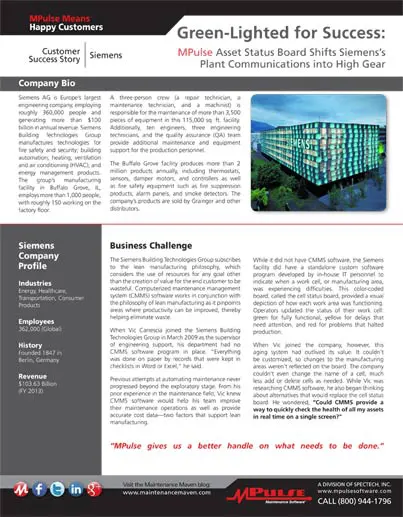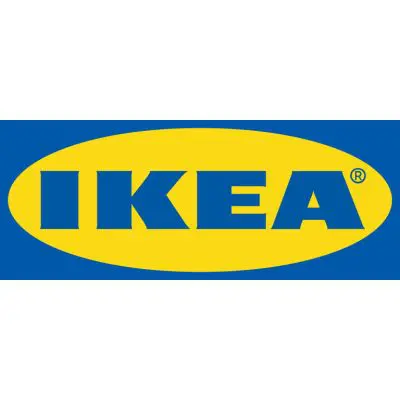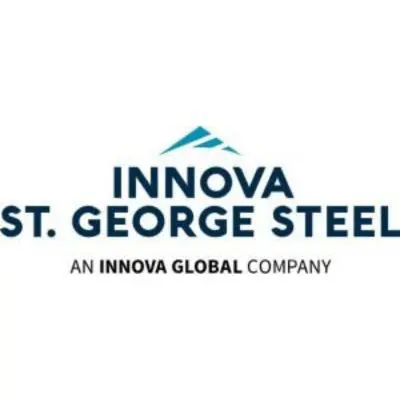MPulse Asset Status Board Shifts Siemens’s Plant Communications into High Gear
Business Challenge
The Siemens Building Technologies Group subscribes to the lean manufacturing philosophy, which considers the use of resources for any goal other than the creation of value for the end customer to be wasteful. Computerized maintenance management system (CMMS) software works in conjunction with the philosophy of lean manufacturing as it pinpoints areas where productivity can be improved, thereby helping eliminate waste.
When Vic Carrescia joined the Siemens Building Technologies Group in March 2009 as the supervisor of engineering support, his department had no CMMS software program in place. “Everything was done on paper by records that were kept in checklists in Word or Excel,” he said.
Previous attempts at automating maintenance never progressed beyond the exploratory stage. From his prior experience in the maintenance field, Vic knew CMMS software would help his team improve their maintenance operations as well as provide accurate cost data—two factors that support lean manufacturing.
While it did not have CMMS software, the Siemens facility did have a standalone custom software program developed by in-house IT personnel to indicate when a work cell, or manufacturing area, was experiencing difficulties. This color-coded board, called the cell status board, provided a visual depiction of how each work area was functioning. Operators updated the status of their work cell: green for fully functional, yellow for delays that need attention, and red for problems that halted production.
When Vic joined the company, however, this aging system had outlived its value. It couldn’t be customized, so changes to the manufacturing areas weren’t reflected on the board. The company couldn’t even change the name of a cell, much less add or delete cells as needed. While Vic was researching CMMS software, he also began thinking about alternatives that would replace the cell status board. He wondered, “Could CMMS provide a way to quickly check the health of all my assets in real time on a single screen?”
Solution
Vic’s facility selected MPulse Gold Edition in 2010 based on the recommendation of another Siemens facility that had already implemented the solution. MPulse Gold Edition offers a complete array of robust features like PM Scheduling, Work Order Management, and Basic Inventory Control. It also includes advanced features like Service Request Management, Vendor Management, Advanced Inventory Tracking, Cost Center Budgeting and Tracking, and Unlimited Custom Tabs and Fields. The company also subscribed to MPulse’s Maintenance and Support Program (MSP) for ongoing technical and usability support, plus access to special services and training.
During an on-site training session with MPulse staff members, Vic saw an opportunity to solve another problem—the aging cell status board. As he worked with MPulse on implementing the new CMMS software, he asked, “Can we incorporate our CMMS to do some of the same things as the cell status board, but with the flexibility we need?”
Vic and the MPulse team worked together to develop a new CMMS feature, dubbed the Asset Status Board (ASB). “The ASB gives us a visual representation of the status of our individual work cells at all times,” Vic explained. Just like the old system, each cell corresponds to a location or work area on the factory floor. When there’s a problem, work cell operators put in a request to the responsible area: test engineering, manufacturing engineering, design, maintenance, machine shop, quality assurance, or material handling. Then the responsible party is immediately alerted to the problem via email.
Best of all, the ASB is now a standard feature of MPulse Silver, Gold, and Platinum—offering all our customers a single-screen view of asset health across production lines, facilities footprints, or fleets of vehicles. The ASB is customizable to fit any organization’s needs. The cells can be configured to represent production lines, cost centers, departments, systems, or individual assets. The customer defines the criteria and chooses which colors indicate the current status—healthy, underperforming, or critical failure.
Benefits
Streamlined Communication
The ASB offers Siemens flexibility it didn’t have before, as well as more streamlined communications. The new technology helps this lean manufacturer reduce waste caused by slow response times and production downtime. Moreover, the ASB ensures everyone in the plant knows what’s going across all their assets with just a glance.
“We have three 42-inch monitors in the different work cell areas, and the supervisors of those areas have the ability to display the ASB on their monitors,” Vic said. “It’s a visual management tool, not only for the operators, but for everyone.”
Improved Preventative Maintenance Scheduling
MPulse provides Siemens with a robust preventive maintenance (PM) scheduling system. “MPulse helps us build our PM schedules,” Vic said. ”Things aren’t forgotten. We’ve pushed it out into our calibration area and our QA area, so now they’re using it as well. We’re able to build all of our instruction sets and schedule the PMs to be done, based on their frequencies.”
Tracking for Training and Certifications
The scheduling capabilities MPulse provides are so strong Vic’s department has found new uses for them. “We’re actually pushing it beyond purely a maintenance function,” he said. “We’re also using it to keep track of things for some of our operators, like required DOT training and hazardous materials training. I’ve built the schedules so we are notified when these things come due, and they don’t fall through the cracks.”
Work Order Management
The full-featured suite of tools provided with MPulse makes it possible to perform and manage a wide range of maintenance tasks, while maintaining a consistent, user-friendly look and feel. Vic relies heavily on the Work Order Management module. “We use it for work orders, work requests, and maintenance tasks,” he says. On average, the Building Technologies Group processes more than 100 work orders per month. Prior to implementing MPulse, there was no tracking mechanism to monitor work order completion.
According to Vic, he now sees monthly work order completion rates in the 85-90% range, with 100% of PM-related work orders being completed each month. MPulse CMMS software also helps the company determine when an asset is no longer an efficient part of the plant—and therefore a source of waste. “We use MPulse to document how many times we had problems with a piece of equipment to help justify replacing it,” Vic said.
Maintenance Records and Operations
Several other MPulse CMMS modules see regular use as well. “We use the Purchasing module to help us keep track of our spare parts,” Vic said. “We use the Employee Records & Vendor Records modules. All of our employees are in the system. We have entered vendors, manufacturers, as well as some of the contractors we utilize, which allows us to include them in our work orders and purchase orders. In the Inventory module, I use all of the inventory records, reorder list, and requisition records to adjust inventory quantities as needed.”
Green-lighted for Success
In the three years since the company implemented MPulse CMMS software, the Siemens Building Technologies Group has moved closer to sustaining its lean manufacturing philosophy. “MPulse gives us a better handle on what needs to be done,” Vic explained.
The impact of the MPulse software is not just because of the solution itself. Vic attributes much of the success to the strong relationship between the companies, which is built on collaboration. “When it comes to working with me, MPulse is very responsive,” he said. “I can call the support guys and get someone right away. They are very helpful.”
Company Bio
Siemens AG is Europe’s largest engineering company, employing roughly 360,000 people and generating more than $100 billion in annual revenue. Siemens Building Technologies Group manufactures technologies for fire safety and security; building automation; heating, ventilation and air conditioning (HVAC); and energy management products. The group’s manufacturing facility in Buffalo Grove, IL, employs more than 1,000 people, with roughly 150 working on the factory floor.
A three-person crew (a repair technician, a maintenance technician, and a machinist) is responsible for the maintenance of more than 3,500 pieces of equipment in this 115,000 sq. ft. facility. Additionally, ten engineers, three engineering technicians, and the quality assurance (QA) team provide additional maintenance and equipment support for the production personnel.
The Buffalo Grove facility produces more than 2 million products annually, including thermostats, sensors, damper motors, and controllers as well as fire safety equipment such as fire suppression products, alarm panels, and smoke detectors. The company’s products are sold by Grainger and other distributors.
Siemens Company Profile
- Industries: Energy, Healthcare, Transportation, Consumer Products
- Employees: 351,000 (Global)
- History: Founded 1847 in Berlin, Germany
- Revenue: $88.43 Billion (FY 2016)








